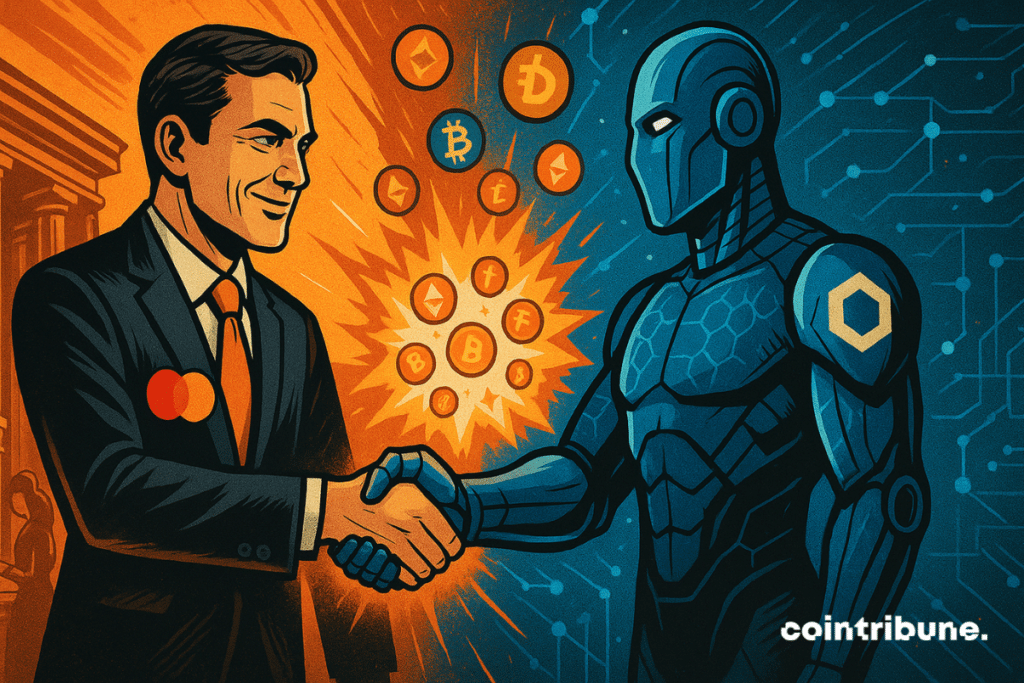Mastercard Makes A Bold Move Into DeFi With Chainlink
As the lines between traditional finance and blockchain become increasingly blurred, Mastercard and Chainlink are reaching a decisive milestone. In a partnership announced this Tuesday, they unveil an on-chain fiat-to-crypto conversion solution designed for Mastercard cardholders. This initiative, far from being anecdotal, redefines access to cryptos and lays the foundation for a new era of hybrid payments between traditional finance and Web3.

In Brief
- Mastercard partners with Chainlink to enable cardholders to purchase cryptocurrencies directly on-chain.
- This partnership aims to simplify access to digital assets through a smooth, secure, and compliant fiat-to-crypto conversion.
- Mastercard intends to connect its over 3 billion users to the decentralized economy without going through exchanges.
- This direct gateway between traditional finance and Web3 could accelerate large-scale crypto adoption.
A Multi-Actor Infrastructure for Integrated Crypto Conversions
While Mastercard had already announced key partnerships to revolutionize crypto payments, the new association between the company and Chainlink is based on a clear ambition: to remove structural barriers that prevent the average user from entering the on-chain economy.
In a press release published last Tuesday, the two companies state that Mastercard cardholders will now be able to “purchase crypto assets directly on-chain through a secure fiat-to-crypto conversion”.
Unlike previous models implemented in recent years, often centered around cards allowing crypto spending via off-chain conversions, this new collaboration relies on direct integration within the on-chain universe. The goal is to provide a seamless, frictionless buying experience that is compliant with regulatory requirements.
To achieve this result, Mastercard and Chainlink rely on a technological ecosystem spread across several key partners, each bringing an essential function to the entire setup :
- Chainlink : a decentralized oracle infrastructure that connects off-chain and on-chain systems ;
- Zerohash : responsible for compliance, custody, and fiat-crypto conversion functions in accordance with regulatory frameworks ;
- Swapper Finance : user interface provider, integrating XSwap, a DEX from the Chainlink ecosystem ;
- Shift4 Payments : manages card payment processing ;
- Uniswap : protocol used to provide on-chain liquidity for conversions.
In their communication, the two companies emphasize that this system relies on an integrated architecture aimed at offering a “unified, compliant, and intuitive user experience”.
For Chainlink, this is a concrete response to years of inefficiency in accessing cryptos: “we are removing longstanding barriers that prevented users from accessing the on-chain economy”. It is a way to open access to cryptos to a much wider audience, beyond insiders and experienced DeFi users.
Towards the Mainstreaming of DeFi Access for Mastercard’s 3 Billion Users
While the technical structure of the project is complex, its ambitions are clear. Mastercard emphasizes its desire to connect users to the crypto universe.
“People want to easily connect to the digital asset ecosystem, and vice versa”, asserts Raj Dhamodharan, Executive Vice President of Blockchain and Digital Assets at Mastercard.
He describes this new solution as “a safe and innovative way to revolutionize on-chain commerce and promote broader crypto adoption”. To meet this ambition, the solution relies on deep integration among all the mentioned actors, promising smooth fiat-to-crypto conversion, all without leaving the on-chain environment.
Thus, Mastercard hopes to reach its more than 3 billion cardholders worldwide, transforming the bank card into a gateway to DeFi.
This strategy marks a break from the company’s previous approaches, often limited to co-branded cards allowing spending of already held crypto. Here, the aim is to make the purchase itself native to the blockchain, relying on decentralized protocols like Uniswap, rather than simulating crypto use within a traditional system.
The partnership with Chainlink thus goes beyond a mere marketing initiative. It lays the foundation for a new standard of crypto access that is more direct, more secure, and potentially more universal.
This announcement raises many questions. Could such a solution disrupt centralized crypto exchange platforms? How will regulators react to such a direct gateway between fiat money and cryptos? And above all, will this integration succeed in convincing an audience still largely hesitant to dive into the DeFi world? Many issues to closely follow in the coming months, as Mastercard seems intent on making on-chain a natural component of the banking experience, as evidenced by the launch with Kraken of a crypto card in Europe and the UK.
Maximize your Cointribune experience with our "Read to Earn" program! For every article you read, earn points and access exclusive rewards. Sign up now and start earning benefits.
Diplômé de Sciences Po Toulouse et titulaire d'une certification consultant blockchain délivrée par Alyra, j'ai rejoint l'aventure Cointribune en 2019. Convaincu du potentiel de la blockchain pour transformer de nombreux secteurs de l'économie, j'ai pris l'engagement de sensibiliser et d'informer le grand public sur cet écosystème en constante évolution. Mon objectif est de permettre à chacun de mieux comprendre la blockchain et de saisir les opportunités qu'elle offre. Je m'efforce chaque jour de fournir une analyse objective de l'actualité, de décrypter les tendances du marché, de relayer les dernières innovations technologiques et de mettre en perspective les enjeux économiques et sociétaux de cette révolution en marche.
The views, thoughts, and opinions expressed in this article belong solely to the author, and should not be taken as investment advice. Do your own research before taking any investment decisions.